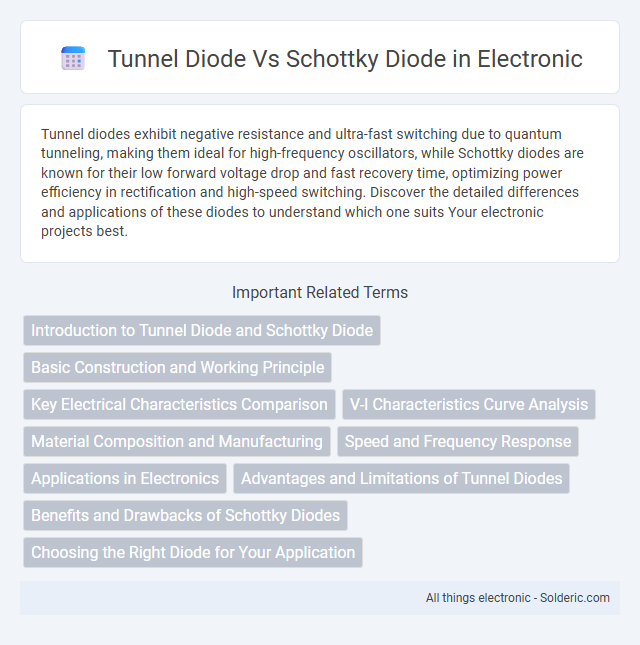Tunnel diodes exhibit negative resistance and ultra-fast switching due to quantum tunneling, making them ideal for high-frequency oscillators, while Schottky diodes are known for their low forward voltage drop and fast recovery time, optimizing power efficiency in rectification and high-speed switching. Discover the detailed differences and applications of these diodes to understand which one suits Your electronic projects best.
Comparison Table
| Feature | Tunnel Diode | Schottky Diode |
|---|---|---|
| Operating Principle | Quantum tunneling effect | Metal-semiconductor junction |
| Forward Voltage Drop | ~0.1 to 0.3 V | ~0.15 to 0.45 V |
| Switching Speed | Extremely fast (picoseconds) | Fast switching (nanoseconds) |
| Application | High-frequency oscillators, microwave circuits | Rectifiers, clamping, RF applications |
| Noise Level | Low noise | Low noise |
| Current Handling | Low to moderate current | Moderate to high current |
| Cost | Higher | Lower |
Introduction to Tunnel Diode and Schottky Diode
Tunnel diodes are quantum mechanical devices characterized by their negative resistance region, enabling ultra-high-speed switching and oscillation in microwave frequencies. Schottky diodes, constructed with a metal-semiconductor junction, offer low forward voltage drop and fast switching speeds, making them ideal for power rectification and radio frequency applications. Both diodes serve critical roles in high-frequency circuits but operate on distinct physical principles affecting their performance and usage.
Basic Construction and Working Principle
A Tunnel diode features a heavily doped p-n junction that allows quantum mechanical tunneling, enabling it to operate at very high speeds with negative resistance characteristics. The Schottky diode consists of a metal-semiconductor junction, typically between a metal and n-type semiconductor, providing fast switching and low forward voltage drop due to majority carrier conduction. Your choice depends on whether quantum tunneling or rapid switching with low forward voltage is more critical for your application.
Key Electrical Characteristics Comparison
Tunnel diodes exhibit extremely high-speed switching with negative resistance regions, allowing them to operate efficiently at microwave frequencies, while Schottky diodes are known for their low forward voltage drop (typically 0.15 to 0.45 V) and fast recovery time, making them ideal for high-speed rectification. Tunnel diodes have low forward voltage (around 0.3 V), but their primary advantage is the negative differential resistance enabling oscillators and amplifiers, whereas Schottky diodes excel in low power loss and high-frequency rectification without the negative resistance effect. Your choice between these diodes depends on the need for ultra-fast switching and microwave applications (Tunnel diode) versus low voltage drop and efficient high-frequency rectification (Schottky diode).
V-I Characteristics Curve Analysis
The Tunnel diode exhibits a unique V-I characteristics curve featuring a negative resistance region caused by quantum tunneling, allowing rapid switching and high-frequency performance. In contrast, the Schottky diode displays a forward voltage drop typically around 0.2 to 0.3 volts and a sharp knee on its curve, indicating fast switching and low forward voltage unlike conventional PN junction diodes. Your choice between these diodes depends on applications where either the negative resistance property of the Tunnel diode or the low forward voltage and fast switching of the Schottky diode is more critical.
Material Composition and Manufacturing
Tunnel diodes are primarily made from heavily doped germanium or gallium arsenide, enabling quantum tunneling through a very thin depletion region, which requires precise epitaxial growth techniques during manufacturing. Schottky diodes typically use a metal-semiconductor junction, combining metals like platinum or gold with n-type silicon, fabricated through standard semiconductor processing that forms a low forward voltage barrier. The distinct material compositions and fabrication methods directly influence the electrical characteristics and application suitability of each diode type.
Speed and Frequency Response
Tunnel diodes exhibit ultra-fast switching speeds due to their quantum tunneling mechanism, enabling operation at frequencies up to several hundred gigahertz, surpassing many conventional diodes. Schottky diodes offer low forward voltage drop and fast recovery times, with frequency responses typically effective in the microwave range, often reaching tens of gigahertz. While tunnel diodes excel in extremely high-frequency applications, Schottky diodes provide a balanced performance suitable for high-speed rectification and RF detection.
Applications in Electronics
Tunnel diodes excel in high-speed switching and microwave frequency oscillators due to their negative resistance region, making them ideal for ultra-fast logic circuits and RF applications. Schottky diodes are widely used in power rectification, clamping, and voltage clamping with low forward voltage drop and fast recovery time, supporting efficient power supplies and RF mixers. Your choice depends on whether your application demands high-frequency performance or efficient power management within electronic circuits.
Advantages and Limitations of Tunnel Diodes
Tunnel diodes offer extremely fast switching speeds and operate efficiently at very high frequencies due to their negative resistance region, making them ideal for microwave and high-frequency applications. However, their low output power and sensitivity to temperature variations limit their use in general-purpose circuits compared to Schottky diodes, which provide higher current capacity, low forward voltage drop, and better thermal stability. The high manufacturing complexity and cost of tunnel diodes further restrict their widespread adoption despite their superior speed advantages.
Benefits and Drawbacks of Schottky Diodes
Schottky diodes offer benefits such as low forward voltage drop, fast switching speed, and high efficiency in power applications, making them ideal for rectifiers and RF circuits. However, they exhibit higher reverse leakage current and lower voltage tolerance compared to tunnel diodes, limiting their use in high-voltage environments. Their simplicity and reliability are offset by susceptibility to thermal runaway under high temperatures.
Choosing the Right Diode for Your Application
Tunnel diodes excel in high-speed switching and low-voltage applications due to their negative resistance region and high-frequency performance, making them ideal for microwave oscillators and amplifiers. Schottky diodes offer fast switching speeds and low forward voltage drop, providing efficient rectification and protection in power supplies and RF circuits. Selecting between tunnel and Schottky diodes depends on requirements such as switching speed, voltage levels, and frequency range to optimize overall circuit performance.
Tunnel diode vs Schottky diode Infographic

 solderic.com
solderic.com